engine Peugeot Bipper 2015 Owner's Manual
[x] Cancel search | Manufacturer: PEUGEOT, Model Year: 2015, Model line: Bipper, Model: Peugeot Bipper 2015Pages: 192, PDF Size: 7.97 MB
Page 5 of 192
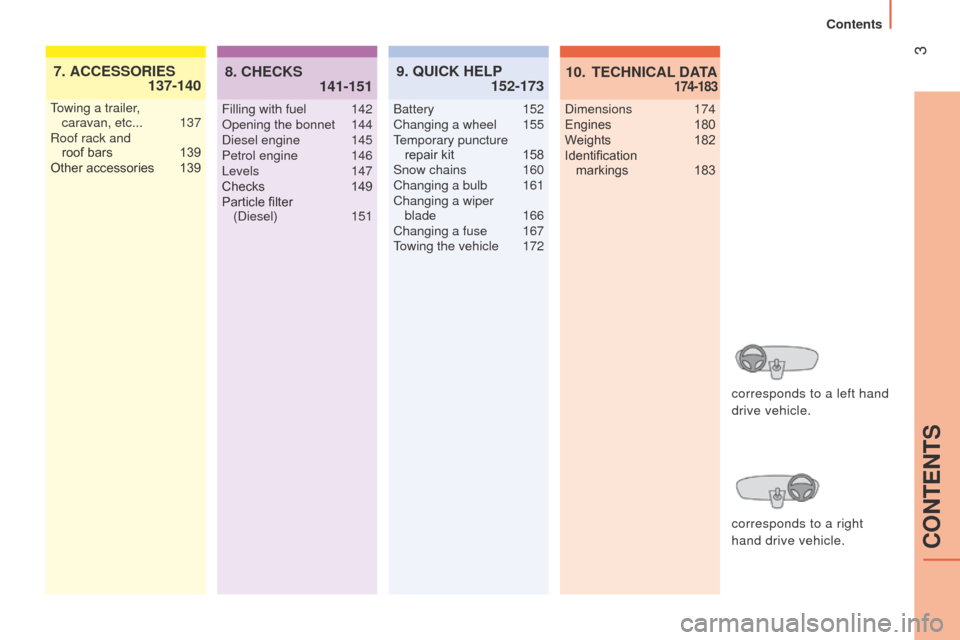
3
Bipper_en_Chap00a_sommaire_ed02-2014
TECHNICAL DATA
10.
174-183ACCESSORIES
7.
137-140
towing a trailer ,
caravan, etc... 137
Roof rack and
roof bars
139
Other accessories
139Filling with fuel
142
Opening the bonnet
144
Diesel engine
145
Petrol engine
146l
evels
147
Checks
149
Particle filter
(Diesel)
151
QUICK HELP
9.
152-173
CHECKS
8.
141-151
Battery 152
Changing a wheel 155temporary puncture repair
kit
158
Snow chains
160
Changing a bulb
161
Changing a wiper blade
166
Changing a fuse
167towing the vehicle
172Dimensions
174
Engines
180
W
eights
182
Identification
markings
183
corresponds to a left hand
drive vehicle.
corresponds to a right
hand drive vehicle.
CONteNtS
Contents
Page 24 of 192

22
Bipper_en_Chap02_eco-conduite_ed02-2014
ENVIRONMENT
With you, PeugeOt acts to protect the
environment.
W
e invite you to visit the www.peugeot.co.uk
website. As the driver, you also can contribute to
protecting the environment by following certain
rules:
Refer to information on eco-driving at the
end of this section.
-
adopt a preventive style of driving, without
frequent and harsh acceleration,
-
observe the service intervals; we
recommend that services are carried out
by a P
euge O t
dealer
, authorised to
collect used batteries and fluids,
-
in order to preserve the reliability of the
engine and emission control systems, do
not use engine oil additives.
Motoring & Environment
Page 25 of 192

23
Bipper_en_Chap02_eco-conduite_ed02-2014
ECO-DRIVING
eco-driving is a range of everyday practices that allow the motorist to o\
ptimise their fuel consumption and CO2 emissions.
Optimise the use of your gearbox
With a manual gearbox, move off gently and change up without
waiting. During acceleration change up early.
With an automatic or electronic gearbox, give preference to automatic
mode and avoid pressing the accelerator pedal heavily or suddenly.
t
he gear shift indicator invites you engage the most suitable gear: as
soon as the indication is displayed in the instrument panel, follow it
straight away.
For vehicles fitted with an electronic or automatic gearbox, this
indicator appears only in manual mode.
Drive smoothly
Maintain a safe distance between vehicles, use engine braking rather
than the brake pedal, and press the accelerator progressively.
t
hese
practices contribute towards a reduction in fuel consumption and CO
2
emissions and also helps reduce the background traffic noise.
If your vehicle has cruise control, make use of the system at speeds
above 25 mph (40 km/h) when the traffic is flowing well.
Control the use of your electrical equipment
Before moving off, if the passenger compartment is too warm, ventilate it
by opening the windows and air vents before using the air conditioning.
Above 30 mph (50 km/h), close the windows and leave the air vents
open.
Remember to make use of equipment that can help keep the
temperature in the passenger compartment down (sunroof and window
blinds...).
Switch off the air conditioning, unless it has automatic regulation, as
soon as the desired temperature is attained.
Switch off the demisting and defrosting controls, if not automatic.
Switch off the heated seat as soon as possible.
Switch off the headlamps and front foglamps when the level of light
does not require their use.
Avoid running the engine before moving off, particularly in winter; your
vehicle will warm up much faster while driving.
As a passenger, if you avoid connecting your multimedia devices
(film, music, video game...), you will contribute towards limiting the
consumption of electrical energy, and so of fuel.
Disconnect your portable devices before leaving the vehicle.
2
ECO-DRIVING
Motoring & Environment
Page 26 of 192
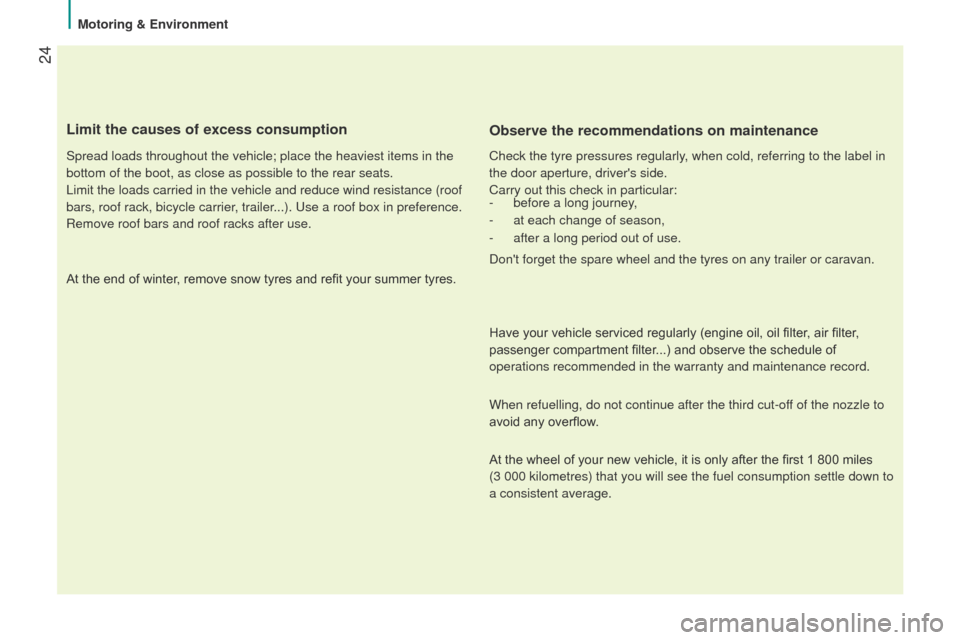
24
Bipper_en_Chap02_eco-conduite_ed02-2014
Limit the causes of excess consumption
Spread loads throughout the vehicle; place the heaviest items in the
bottom of the boot, as close as possible to the rear seats.
l
imit the loads carried in the vehicle and reduce wind resistance (roof \
bars, roof rack, bicycle carrier, trailer...).
u se a roof box in preference.
Remove roof bars and roof racks after use.
At the end of winter, remove snow tyres and refit your summer tyres.
Observe the recommendations on maintenance
Check the tyre pressures regularly, when cold, referring to the label in
the door aperture, driver's side.
Carry out this check in particular:
-
before a long journey
,
-
at each change of season,
-
after a long period out of use.
Don't forget the spare wheel and the tyres on any trailer or caravan.
Have your vehicle serviced regularly (engine oil, oil filter
, air filter,
passenger compartment filter...) and observe the schedule of
operations recommended in the warranty and maintenance record.
When refuelling, do not continue after the third cut-off of the nozzle to
avoid any overflow.
At the wheel of your new vehicle, it is only after the first 1 800 miles
(3
000 kilometres) that you will see the fuel consumption settle down to
a consistent average.
Motoring & Environment
Page 28 of 192
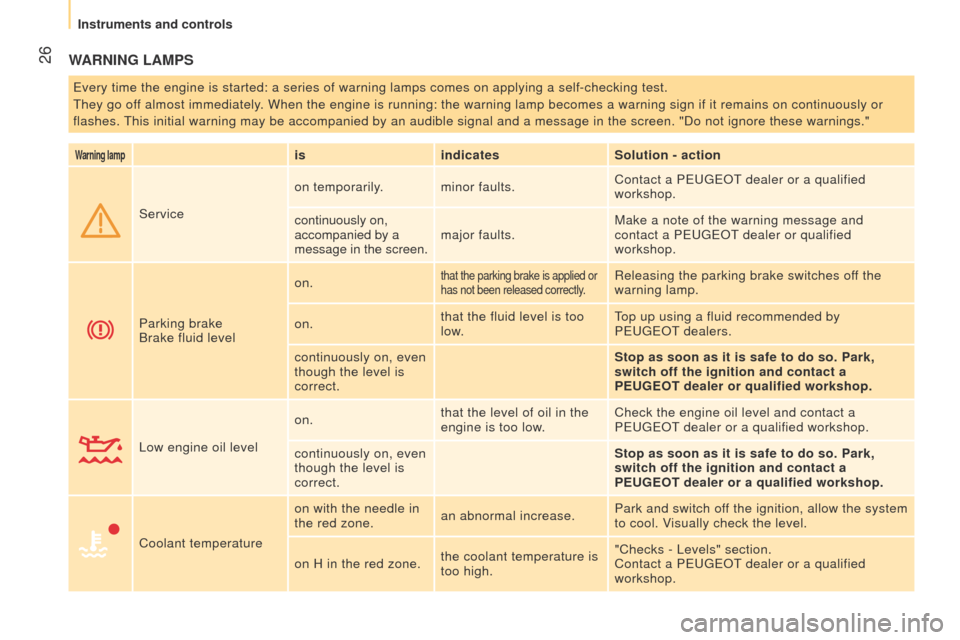
26
Bipper_en_Chap03_pret-a-partir_ed02-2014
WARNING LAMPS
every time the engine is started: a series of warning lamps comes on appl\
ying a self-checking test.
t
hey go off almost immediately. When the engine is running: the warning lamp becomes a warning sign if\
it remains on continuously or
flashes.
t
his initial warning may be accompanied by an audible signal and a messag\
e in the screen. "Do not ignore these warnings."
Warning lampis indicates Solution - action
Service on temporarily. minor faults.
Contact a P
euge O t
dealer or a qualified
workshop.
continuously on,
accompanied by a
message in the screen. major faults. Make a note of the warning message and
contact a P
euge O t
dealer or qualified
workshop.
Parking brake
Brake fluid level on.
that the parking brake is applied or
has not been released correctly.Releasing the parking brake switches off the
warning lamp.
on. that the fluid level is too
low.
top up using a fluid recommended by
P
euge O t
dealers.
continuously on, even
though the level is
correct. Stop as soon as it is safe to do so. Park,
switch off the ignition and contact a
PEUGEOT dealer or qualified workshop.
l
ow engine oil level on.
that the level of oil in the
engine is too low. Check the engine oil level and contact a
P
euge O t
dealer or a qualified workshop.
continuously on, even
though the level is
correct. Stop as soon as it is safe to do so. Park,
switch off the ignition and contact a
PEUGEOT dealer or a qualified workshop.
Coolant temperature on with the needle in
the red zone.
an abnormal increase. Park and switch off the ignition, allow the system
to cool. Visually check the level.
on H in the red zone. the coolant temperature is
too high. "Checks -
l evels" section.
Contact a P
euge O t
dealer or a qualified
workshop.
Instruments and controls
Page 29 of 192
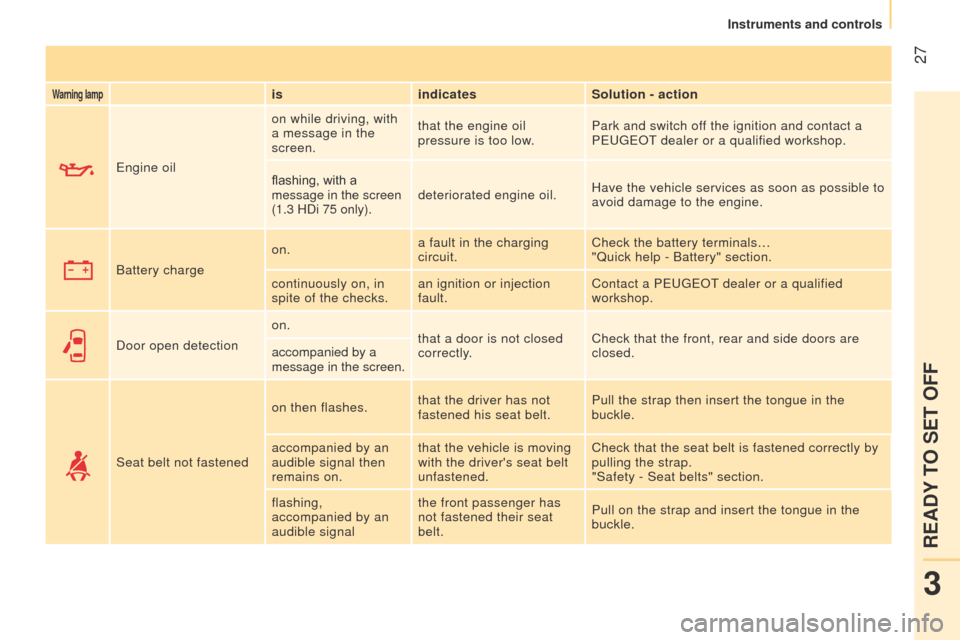
27
Bipper_en_Chap03_pret-a-partir_ed02-2014
Warning lampisindicates Solution - action
e
ngine oil on while driving, with
a message in the
screen.
that the engine oil
pressure is too low.
Park and switch off the ignition and contact a
P
euge O t
dealer or a qualified workshop.
flashing, with a
message in the screen
(1.3 HDi 75 only). deteriorated engine oil.
Have the vehicle services as soon as possible to
avoid damage to the engine.
Battery charge on.
a fault in the charging
circuit. Check the battery terminals…
"Quick help - Battery" section.
continuously on, in
spite of the checks. an ignition or injection
fault. Contact a P
euge O t
dealer or a qualified
workshop.
Door open detection on.
that a door is not closed
correctly. Check that the front, rear and side doors are
closed.
accompanied by a
message in the screen.
Seat belt not fastened on then flashes.
that the driver has not
fastened his seat belt. Pull the strap then insert the tongue in the
buckle.
accompanied by an
audible signal then
remains on. that the vehicle is moving
with the driver's seat belt
unfastened. Check that the seat belt is fastened correctly by
pulling the strap.
"Safety - Seat belts" section.
flashing,
accompanied by an
audible signal the front passenger has
not fastened their seat
belt.
Pull on the strap and insert the tongue in the
buckle.
3
READY TO SET OFF
Instruments and controls
Page 32 of 192

30
Bipper_en_Chap03_pret-a-partir_ed02-2014
Warning lampisindicates Solution - action
e
lectronic anti-theft on.the ignition key introduced
is not recognised.
Starting impossible.
u
se another key and have the faulty key
checked by a P
euge O t
dealer
.
"Ready to set off - Access" section.
e
missions control
system flashing or on
continuously.
a fault with the system. Have it checked as soon as possible by a
P
euge O t
dealer or a qualified workshop.
l
ow fuel level on with the gauge
needle in zone
e .that the fuel reserve is
being used. Refuel without delay.
t
he assessment of the
fuel reserve is sensitive to the style of driving,
the profile of the road, the time elapsed and the
distance travelled since the warning lamp first
came on.
Particle filter on, accompanied by
an audible signal and a
message in the screen.the start of saturation of
the particle filter.
Regenerate the filter as soon as possible.
"Checks" section.
Presence of water in
the Diesel filter on, accompanied by
a message in the
screen.water in the Diesel fuel
filter. Have the filter bled by a P
euge O t
dealer or a
qualified workshop.
"Checks" section.
Diesel pre-heating on.that the weather
conditions impose pre-
heating (up to around
30 seconds in extreme
climatic conditions). Wait for the warning lamp to switch off before
operating the starter.
If the engine does not start, switch the ignition
off and on again, wait for the warning lamp to go
off, and start the engine.
Instruments and controls
Page 35 of 192
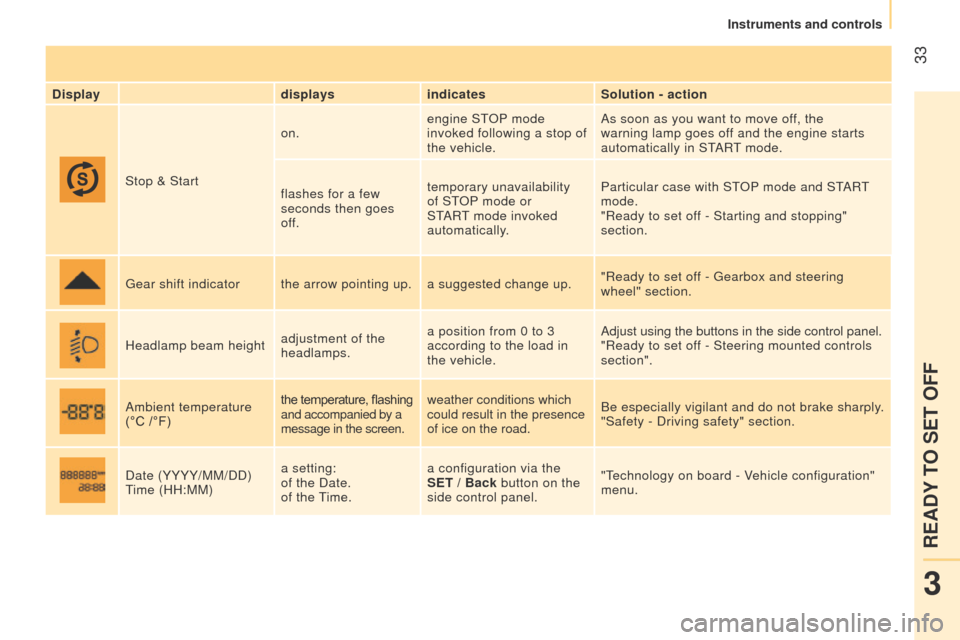
33
Bipper_en_Chap03_pret-a-partir_ed02-2014
Displaydisplaysindicates Solution - action
Stop & Start on.
engine S
t
OP
mode
invoked following a stop of
the vehicle. As soon as you want to move off, the
warning lamp goes off and the engine starts
automatically in S
t
ARt mode.
flashes for a few
seconds then goes
off. temporary unavailability
of S
t
OP
mode or
S
t
ARt mode invoked
automatically. Particular case with S
t
OP
mode and S t
ARt
mode.
"Ready to set of
f - Starting and stopping"
section.
g
ear shift indicator the arrow pointing up. a suggested change up. "Ready to set off -
g earbox and steering
wheel" section.
Headlamp beam height adjustment of the
headlamps.a position from 0 to 3
according to the load in
the vehicle. Adjust using the buttons in the side control panel.
"Ready to set off - Steering mounted controls
section".
Ambient temperature
(°C /°F) the temperature, flashing
and accompanied by a
message in the screen.weather conditions which
could result in the presence
of ice on the road.
Be especially vigilant and do not brake sharply.
"Safety - Driving safety" section.
Date (YYYY/MM/DD)
time (HH:MM) a setting:
of the Date.
of
the t
ime.a configuration via the
SET / Back button on the
side control panel. "
t
echnology on board - V
ehicle configuration"
menu.
3
READY TO SET OFF
Instruments and controls
Page 36 of 192
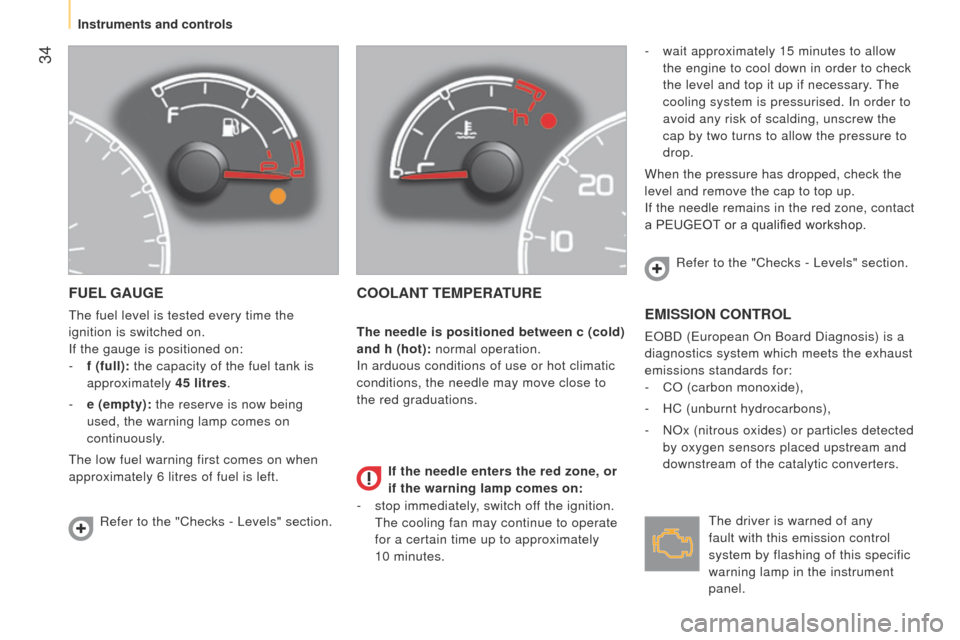
34
Bipper_en_Chap03_pret-a-partir_ed02-2014
FUEL GAUGE
the fuel level is tested every time the
ignition is switched on.
If the gauge is positioned on:
-
f (full):
the capacity of the fuel tank is
approximately 45 litres.
-
e (empty):
the reserve is now being
used, the warning lamp comes on
continuously.
t
he low fuel warning first comes on when
approximately 6 litres of fuel is left.
COOLANT TEMPERATURE
- wait approximately 15 minutes to allow
the engine to cool down in order to check
the level and top it up if necessary.
t
he
cooling system is pressurised. In order to
avoid any risk of scalding, unscrew the
cap by two turns to allow the pressure to
drop.
When the pressure has dropped, check the
level and remove the cap to top up.
If the needle remains in the red zone, contact
a PEUGEOT or a qualified workshop.
EMISSION CONTROL
eOBD (european On Board Diagnosis) is a
diagnostics system which meets the exhaust
emissions standards for:
-
CO (carbon monoxide),
-
HC (unburnt hydrocarbons),
-
NOx (nitrous oxides) or particles detected
by oxygen sensors placed upstream and
downstream of the catalytic converters.
Refer to the "Checks -
l
evels" section. Refer to the "Checks -
l evels" section.
t
he driver is warned of any
fault with this emission control
system by flashing of this specific
warning lamp in the instrument
panel.
If the needle enters the red zone, or
if the warning lamp comes on:
The needle is positioned between c (cold)
and h (hot): normal operation.
In arduous conditions of use or hot climatic
conditions, the needle may move close to
the red graduations.
-
stop immediately
, switch off the ignition.
t
he cooling fan may continue to operate
for a certain time up to approximately
10
minutes.
Instruments and controls
Page 37 of 192
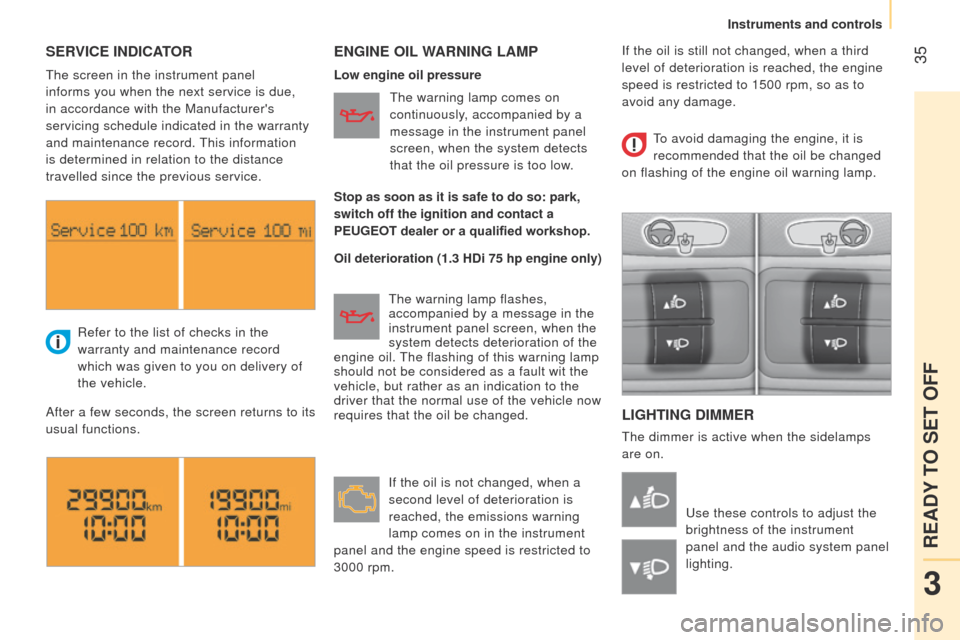
35
Bipper_en_Chap03_pret-a-partir_ed02-2014
SERVICE INDICATORENGINE OIL WARNING LAMP
L IGHTING DIMMER
the dimmer is active when the sidelamps
are on.
Refer to the list of checks in the
warranty and maintenance record
which was given to you on delivery of
the vehicle.
After a few seconds, the screen returns to its
usual functions.
u
se these controls to adjust the
brightness of the instrument
panel and the audio system panel
lighting.
t
he screen in the instrument panel
informs you when the next service is due,
in accordance with the Manufacturer's
servicing schedule indicated in the warranty
and maintenance record.
t
his information
is determined in relation to the distance
travelled since the previous service. Low engine oil pressure
Oil deterioration (1.3 HDi 75 hp engine only)
t
he warning lamp comes on
continuously, accompanied by a
message in the instrument panel
screen, when the system detects
that the oil pressure is too low.
t
he warning lamp flashes,
accompanied by a message in the
instrument panel screen, when the
system detects deterioration of the
engine oil.
t
he flashing of this warning lamp
should not be considered as a fault wit the
vehicle, but rather as an indication to the
driver that the normal use of the vehicle now
requires that the oil be changed.
If the oil is not changed, when a
second level of deterioration is
reached, the emissions warning
lamp comes on in the instrument
panel and the engine speed is restricted to
3000 rpm.
to avoid damaging the engine, it is
recommended that the oil be changed
on flashing of the engine oil warning lamp.
Stop as soon as it is safe to do so: park,
switch off the ignition and contact a
PEUGEOT dealer or a qualified workshop. If the oil is still not changed, when a third
level of deterioration is reached, the engine
speed is restricted to 1500 rpm, so as to
avoid any damage.
3
READY TO SET OFF
Instruments and controls